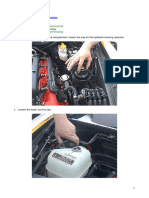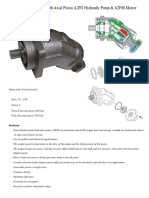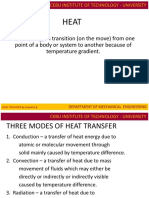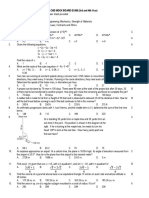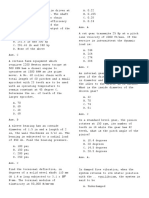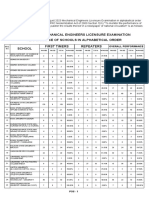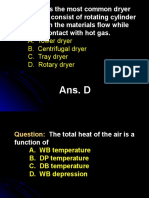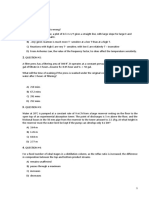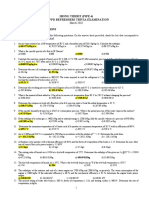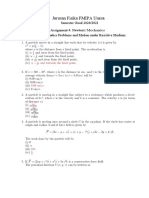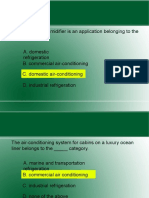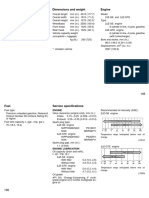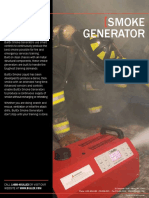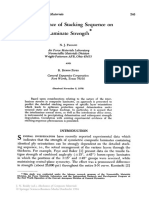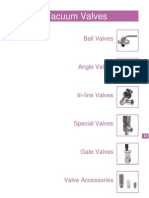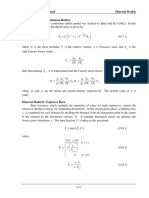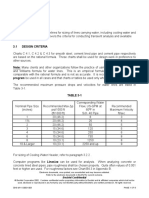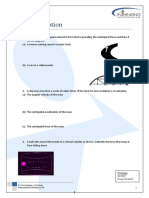Day 2 Board Review
Day 2 Board Review
Uploaded by
AkiCopyright:
Available Formats
Day 2 Board Review
Day 2 Board Review
Uploaded by
AkiCopyright
Available Formats
Share this document
Did you find this document useful?
Is this content inappropriate?
Copyright:
Available Formats
Day 2 Board Review
Day 2 Board Review
Uploaded by
AkiCopyright:
Available Formats
A steel casting (Cp = 0.
50 kJ/kg-K) weighing 40 kg and at a
temperature of 450 deg C is quenched in 150 kg of oil (Cp = 2.5 kJ/kg-
K) at 25 deg C. If there are no heat losses,
1) What is the entropy change of the casting (kJ/kg)?
a) 9.80 b) 26.13 c) 46.52 d) -16.33
2) What is the entropy change of the oil (kJ/kg)?
a) 9.80 b) 26.13 c) 46.52 d) -16.33
3) What is the entropy change of the entire process (kJ/kg)?
a) 9.80 b) 26.13 c) 46.52 d) -16.33
A light hydrocarbon oil flows inside a 2-in. Sch. 40 steel pipe (I.D.
= 2.067 in., O.D. = 2.375 in.) in a double-pipe heat exchanger at 8600
lb/hr. It is cooled from 240°F to 138.5°F. Water will enter the
annulus at 45°F and will flow counter-current to the oil at a rate of
4,400 lb/hr.
Heat capacity of oil = 0.55 Btu/lb-°F
Heat capacity of water = 1.0 Btu/lb-°F
The overall heat-transfer coefficient based on the inside area is 60
Btu/hr-ft2-°F.
4) The duty (Btu/hr) of the heat exchanger is
a) 680,095 b) 380,095 c) 580,095 d) 480,095
5) The log mean temperature difference (deg F) is
a) 100.64 b) 89.64 c) 79.64 d) 69.64
6) The inside area (ft2) of the heat exchanger is most nearly:
a) 100.26 b) 89.26 c) 79.62 d) 69.82
A 1-2 shell-&-tube heat exchanger heats 2.52 kg/s of water (Cp = 4.2
kJ/kg-K) from 21.1oC to 54.4oC using hot water entering at 115.6oC and
leaving at 60.0oC. The overall heat transfer coefficient is 1000 W/m2-
K. Assume a fudge factor, F, of 0.98.
7) The corrected log mean temperature difference is
a) 49.21 b) 57.64 c) 84.75 d) 97.45
8) The duty (kJ/s) of heat exchanger is
a) 523.45 b) 325.54 c) 352.45 d)545.23
9) How many 1.5-m-long tubes per tube-pass are required if each tube
has an outside diameter of 3 cm?
a) 46 b) 16 c) 36 d) 26
Water at 200 0F (density = 60.11 lbm/ft3) is pumped from a storage tank
at the rate of 50 gal/min. The motor for the pump supplies work at
the rate of 2 HP. The water goes through a heat exchanger, giving up
heat at the rate of 40,000 Btu/min, and is delivered to a second
storage tank at an elevation of 50 ft above the first tank.
10) What is the change in potential energy (Btu/lbm)?
a) 0.406 b) 0.604 c) 0.046 d) 0.064
11) What is the change in enthalpy (Btu/lbm)?
a) 1 b) 2 c) -99.35 d) 99.35
12) What is the temperature of the water delivered to the second
tank?
a) 200.74 b) 300.74 c) 500.74 d) 100.74 deg F
At 3000 K and 1 atm, H2S is 40% dissociated into H2 and S2.
13) Calculate KP for the reaction.
a) 0.054 b) 0.064 c) 0.074 d) 0.084
14) What will be the degree of dissociation if the pressure is raised
to 2 atm?
a) 0.5 b) 0.748 c) 0.336 d) 0.633
15) What will be the degree of dissociation when a mixture of 50% H 2S
and 50% O2 is heated to 3000 K, the pressure being 1 atm?
a) 0.315 b) 0.271 c) 0.315 d) 0.423
16) The width of apron conveyor having a capacity of 75 tons/h and a
speed of 50 ft/min is
a) 1220 mm b)1070 mm c) 1370 mm d) 460 mm
17) Determine the maximum horsepower requirement of a screw conveyor
with a capacity of 30 tons/h and a speed of 55 rpm.
a) 14.3 hp b) 30.6 hp c) 10 hp d) 5 hp
18) Determine the capacity of a flight conveyor having a flight size
and number of strands in mm of 15 x 7 (380 x 180) – 1
specification.
a) 61 MT/h b) 113 MT/h c) 71 MT/h d) 81 MT/h
19) Convert 4 therm to MJ
a) 422 MJ b) 322 MJ c) 122 MJ d) 522 MJ
20) A given flowrate of 1000 gpm is the same as
a) 1124.67 ft3/hr b) 8021 ft3/hr c) 22.228 ft3/hr d) 22.28 ft3/hr
21) Convert 60 BTU/lbm-deg F to J/kg-K
a) 0.0143 b) 250,668 c) 139,560 d) 452,174
A mixture of 55.13% carbon dioxide and 44.87% hydrogen is passed over
a nickel catalyst. The temperature of the catalyst bed is 588 K (315 )
and the reactor pressure is 2 MPa g. The analysis of the gases leaving
the reactor showed CO2: 55.18%, H2: 39.72%, CH4: 1.62%, CO: 0.12% and
H2O: 3.36%. The reaction taking place in the reactor is:
CO2 + 4 H2 = CH4 + 2 H2O
and CO2 + H2 = CO + H2O
22) Find the conversion of CO2 per pass
a) 1.06% b) 2.06% c) 3.06% d) 4.06%
23) Find the yield of CH4 in terms of CO2 reacted
a) 83.33% b) 93.10% c) 73.33% d) 63.33%
24) Find the selectivity of CH4 to CO production
a) 11.5 b) 12.5 c) 13.5 d) 14.5
A pure saturated hydrocarbon (CnH2n+2) is burned with excess air. Orsat
analysis of the products of combustion shows 9.08% CO2, 1.63% CO, 5.28%
O2 and no free H2.
25) Determine the formula of the hydrocarbon
a) CH4 b) C2H6 c) C3H8 d) C4H10
26) Calculate the percent excess air
a) 30% b) 25% c) 35% d) 40%
27) Calculate the kg dry air/kg of hydrocarbon
a) 19.62% b) 29.62% c) 39.62% d) 49.62%
28) What is the heat flow through insulating brick, 30 cm thick, in an
oven wall with thermal conductivity of 0.066 W/m-K? The thermal
gradient is 195°C
a) 32.9 W/m2 b) 42.9 W/m2 c) 52.9 W/m2 d) 62.9 W/m2
A composite wall is made up of 3.0 in. of material A exposed to
1000°F, 5.0 in. of material B, and 6.0 in. of material C exposed to
200°F. The mean thermal conductivities for materials A, B, and C are
0.06, 0.5, and 0.8 Btu-ft/hr-ft2-°F, respectively. What are the
temperatures at the A-B and B-C material interfaces?
29) Determine the temperature at A-B material interface.
a) 407.41°F b) 507.41°F c) 607.41°F d) 707.41°F
30) Determine the temperature at B-C material interface.
a) 188.89°F b) 288.89°F c) 388.89°F d) 488.89°F
On a hot summer day the temperature is 35 deg C, barometric pressure
is 103 kPa, and the relative humidity is 90%. An air conditioner draws
in outside air, cools it to 20 deg C, and delivers it at a rate of
12,500 L/h.
31) Calculate the rate of moisture condensation (kg/h).
a) 0.580 b) 0.265 c) 0.352 d) 0.489
32) Calculate the volumetric flow rate of the air drawn from the
outside (L/h).
a) 11,500 b) 12,500 c) 13,500 d) 14,500
33) Calculate the mole fraction of H2O in the inlet stream.
a) 0.04913 b) 0.05913 c) 0.06913 d) 0.07913
We wish to extract nicotine from water using kerosene. If we have 100
lb of 2% nicotine solution extracted once with 200 lb of kerosene.
What percentage of the nicotine will be extracted?
Equilibrium:
34) What percentage of the nicotine will be extracted?
a) 64.75% b) 77.45% c) 82.45% d) 99.60%
A mixture of 45% by weight ethanol and 55% by weight water is
distilled at 1 atm to give a distillate containing 88% by weight
ethanol and bottoms containing 5% by weight ethanol. The feed is
introduced as a subcooled liquid at a rate of 500 kg/h. The reflux
ratio is 2.5.
35) The amount of distillate produced is
a) 396.40 kg/h b) 240.96 kg/h c) 520.32 kg/h d) 140.96 kg/h
36) A salt solution weighing 10,000 kg with 30 wt% Na2CO3 is cooled to
293 K (20°C). The salt crystallizes as decahydrate. What will be the
yield of Na2CO3 10H2O crystals if the solubility is 21.5 kg anhydrous
Na2CO3/100 kg of total water? Assume that 3% of the total weight of
the solution is lost by evaporation of water in cooling. (M.W. Na2CO3
= 106; H2O = 18.02; Na2CO3 10H2O = 286.2)
a) 6636.17 kg b) 5636.17 kg c) 4636.17 kg d) 7636.17 kg
37) A batch liquid with a heat capacity (C P) of 3.8 kJ/kg-K and weighing
1,000 kg is heated by means of a submerged steam coil with an area
(A) of 1 m2. The overall heat-transfer coefficient (U) is 600 W/m2-K.
The heat loss to the surroundings can be neglected. The appropriate
differential equation that describes this heating process is:
Where:
w = batch discharge, kg
TS = steam temperature, K
T = batch liquid temperature, K
= time, s
If the liquid takes 90 min to heat from 290 K to 360 K, then the
saturated steam temperature is most nearly:
a)112.01 K b) 212.01 K c) 312.01 K d) 412.01 K
38) A porous solid is dried in a batch dryer. The critical moisture
content for the solid is determined to be 0.16 lb water/lb dry
solid, and the equilibrium moisture content is 0.02 lb water/lb dry
solid. The mass of dry solid is 2 lb and the drying surface is 1
ft2. The constant drying rate is 0.08 lb/ft 2-hr. If the solid is
dried from 0.3 lb water/lb dry solid to 0.16 lb water/lb dry solid,
then the time required (min) is most nearly:
a) 210 min b) 310 min c)410 min d) 510 min
39) A mixture of 25 mole percent n-pentane, 45 mole percent n-hexane,
and 30 mole percent heptane at 1 atm. What is the degree of freedom
of the mixture as its dew point?
a) 2 b) 3 c) 1 d) 4
40) In a chemical process, oil is flowing through a 2-in. I.D. iron pipe
at a velocity of 3 ft/sec. The following physical properties of the
oil are given:
Density, ρ = 55 lbm/ft3
Heat capacity = 0.518 Btu/lbm-°F
Viscosity, μ = 5.08 lbm/ft-hr
Thermal conductivity, k = 2.17 x 10-5 Btu/sec-ft-°F
The Prandtl number for this flow is most nearly:
a) 22.68 b) 33.68 c) 44.68 d) 55.68
An air standard Diesel cycle absorbs 1,500 J/mol of heat. The pressure
and temperature at the beginning of the compression step are 1 bar and
20 deg C, and the pressure at the end of the compression step is 5
bar. Assuming air to be an ideal gas for which Cp = (7/2)R and Cv =
(5/2)R,
41) Determine the compression ratio of the cycle.
a) 3.157 b) 2.842 c) 1.157 d)4.842
42) Determine the expansion ratio of the cycle.
a) 4.842 b) 1.157 c) 2.842 d) 3.157
43) Calculate the efficiency of the cycle.
a) 34.84% b) 50.25% c) 44.84% d) 60.25%
44) A trayed tower operating at 1 atm is to be designed to continuously
distill 200 kmoles/hour (55.6 moles/s) of a binary mixure of 60 mole
% benzene, 40 mole% toluene.
Antoine’s constants
Benzene Toluene
A = 6.90565 A = 6.95464
B = 1211.033 B = 1344.8
C = 220.79 C = 219.482
What is the T bubble point of the mixture?
a) 99.33°C b) 109.33°C c) 89.33°C d) 79.33
45) Which of the following theories predicts that kl µ D 0.67
?
a) Penetration theory
b) Surface renewal theory
c) Boundary layer theory
d) None of these
46) Corresponding to Prandtl number in heat transfer, the dimensionless
group in mass transfer is
a) Reynolds number c) Peclet number
b) Sherwood number d) Schmidt number
47) Kremser equation may be used to determine the number of stages in a
staged column when
a) the operating and equilibrium lines are straight
b) the operating line is straight, but the equilibrium relation is
curved
c) the operating line is curved, but the equilibrium line is
straight
d) both the operating and equilibrium lines are curved
48) A good solvent for gas absorption should have
a) high vapor pressure and low viscosity
b) high vapor pressure and high viscosity
c) low vapor pressure and low viscosity
d) low vapor pressure and high viscosity
49) The solvent widely employed for natural gas dehydration is
a) monoethanolamine
b) ethylene glycol
c) conc. sulfuric acid
d) calcium chloride
50) For sweetening of sour gases, solvents that are widely employed are
a) mono-and diethanolamines
b) wash oil of molecular weight higher than 300
c) aqueous NaOH solution
d) both (a) and (c)
51) Distillation operations carried out at total reflux do not permit
the removal of any product. However, runs at total reflux are often
made to determine
a) Reboiler duty c) condenser duty
b) theo no. of stages d) pinch point
52) A liquid mixture whose composition and boiling point does not change
as vapor is generated and removed on boiling.
a) Immiscible Liquid Mixture
b) Partially Miscible Liquid mixture
c) Azeotropic Mixture
d) Saturated Mixture
53) When the feed to a distillation column is a saturated vapor, the
feed line is
a) Inclined to the left c) horizontal
b) Inclined to the right d) vertical
54) Corresponding to Nusselt number in heat transfer, the dimensionless
group in mass transfer is
a) Peclet number c) Prandtl number
b) Knudsen number d) Sherwood number
55) Stanton number for mass transfer is defined as
a) Sc / (Sh.Re) c) (Re.Sh) / Sc
b) Re / (Sc.Sh) d) Sh / (Re.Sc)
56) Which of the following analogies gives St = f / 2?
a) Reynolds analogy c) Chilton-Colburn Analogy
b) Prandtl analogy d) none of these
57) Plasticizers are added to paints to
a) make it corrosion resistant
b) make glossy surface
c) give elasticity and prevent cracking of the film
d) increase atmospheric oxidation
58) Which oil is preferred for paint manufacture?
a) drying oil
b) non-drying oil
c) semi-drying oil
d) saturated oil
59) Function of thinner in a paint is to
a) accelerate the oxidation of oil
b) prevent gelling of the paint
c) suspend pigments and dissolve film-forming materials
d) form a protective film
60) As predicted by stokes’ law, the drag coefficient, CD , is given by
a) 16/ NRe,p
b) 8/ NRe,p
c) 24/ NRe,p
d) 32/ NRe,p
You might also like
- Trator Esteira 700J - John Deere - PC10040P PDFDocument716 pagesTrator Esteira 700J - John Deere - PC10040P PDFRaphael Oliveira83% (6)
- Maserati M138 Coupe Workshop ManualDocument723 pagesMaserati M138 Coupe Workshop Manualsamuel100% (1)
- CH138P WS 1.2 Geromo HALDocument11 pagesCH138P WS 1.2 Geromo HALLora Bell100% (1)
- Exp 7 Abst, Intro, and AtqDocument6 pagesExp 7 Abst, Intro, and AtqChali HaineNo ratings yet
- Day 2 1 PDFDocument17 pagesDay 2 1 PDFChristianNo ratings yet
- Rexroth Axial Piston A2FO Hydraulic Pump & A2FM Motor: Open and Closed CircuitsDocument11 pagesRexroth Axial Piston A2FO Hydraulic Pump & A2FM Motor: Open and Closed CircuitsKaian Oliveira100% (1)
- Che 411A: Fluid MechanicsDocument14 pagesChe 411A: Fluid MechanicsChristine Mae VeaNo ratings yet
- T 1 SolDocument5 pagesT 1 SolMichael Alex MabaoNo ratings yet
- Reviewer Key For Comprehensive ExamDocument9 pagesReviewer Key For Comprehensive ExamEmmanuel Lacsamana BobisNo ratings yet
- Heat TransferDocument41 pagesHeat TransferJoshua OliverNo ratings yet
- Engineering EconomyDocument4 pagesEngineering EconomyRochelle Louise SampagaNo ratings yet
- PROBLEM 3.39: SolutionDocument21 pagesPROBLEM 3.39: Solutionنزار الدهاميNo ratings yet
- Sample Problem ThermoDocument25 pagesSample Problem ThermoJonnah Faye Mojares0% (1)
- Day 2 2 PDFDocument10 pagesDay 2 2 PDFChristianNo ratings yet
- ATT - 1432636866961 - Power Plant Exam 2012Document13 pagesATT - 1432636866961 - Power Plant Exam 2012Jimwell AxalanNo ratings yet
- Physics 1 Competency ExamDocument5 pagesPhysics 1 Competency ExamVernadete De Villa0% (1)
- IPD PPD Solved Problems and Answered Elements (September 2013)Document34 pagesIPD PPD Solved Problems and Answered Elements (September 2013)James Tnecniv AlborteNo ratings yet
- AT12 MabaoDocument17 pagesAT12 MabaoMichael Alex MabaoNo ratings yet
- Power and Industrial Plant Engineering 1Document7 pagesPower and Industrial Plant Engineering 1Ella Grace GalangNo ratings yet
- Exercise Flow of FluidsDocument2 pagesExercise Flow of FluidsJD6 AgarbNo ratings yet
- 150 CDocument12 pages150 Crobert carbungco100% (2)
- ThermodynamicsDocument2 pagesThermodynamicsmarkalvinbonNo ratings yet
- General Engineering Principles-Che Mock Board Exam (3Rd and 4Th Year)Document4 pagesGeneral Engineering Principles-Che Mock Board Exam (3Rd and 4Th Year)Ma Theresa CabiazaNo ratings yet
- 3.ionic Equilibria and Biochemical ReactionsDocument4 pages3.ionic Equilibria and Biochemical ReactionsbackseeNo ratings yet
- Linx JCSF Mathematics (Problems and Elements)Document38 pagesLinx JCSF Mathematics (Problems and Elements)Kim Howard CastilloNo ratings yet
- Day 3Document3 pagesDay 3Theresa TuliaoNo ratings yet
- ReviewerDocument22 pagesReviewerRobert DelfinNo ratings yet
- Apolakai - Docx Version 1Document21 pagesApolakai - Docx Version 1AjayBravo100% (1)
- Lecture 3 The First Law and Other Basic Concepts For StudentsDocument58 pagesLecture 3 The First Law and Other Basic Concepts For StudentsJatskinesisNo ratings yet
- Industrial/Power Plant Engineering: Prepared By: Engr. Jose R. FranciscoDocument6 pagesIndustrial/Power Plant Engineering: Prepared By: Engr. Jose R. FranciscoJerick HernandezNo ratings yet
- Chemical Reaction PDFDocument4 pagesChemical Reaction PDFonyxNo ratings yet
- Reviewer 6Document7 pagesReviewer 6tiburciomadlangtutaNo ratings yet
- Yes PleaseDocument14 pagesYes Pleasejaime1234No ratings yet
- Process Control ProblemsDocument4 pagesProcess Control ProblemsMarco Sarmiento100% (1)
- Months 6 Year 5 - 0 18 - 0 5000 450 Pi I NDocument4 pagesMonths 6 Year 5 - 0 18 - 0 5000 450 Pi I NDayLe Ferrer Abapo0% (1)
- PIPE ElementsDocument99 pagesPIPE ElementsJustin MercadoNo ratings yet
- August 2023 Mechanical Engineers Licensure Examination POSDocument9 pagesAugust 2023 Mechanical Engineers Licensure Examination POSRapplerNo ratings yet
- Thermo 1-Problem Set Part 2Document5 pagesThermo 1-Problem Set Part 2Elisif DeFairNo ratings yet
- Exam Final Preboard Gen EngDocument6 pagesExam Final Preboard Gen EngAira Jean ManingoNo ratings yet
- Coaching 150 Pipe UpDocument150 pagesCoaching 150 Pipe Uprobert carbungco100% (1)
- HT Solved NumericalsDocument56 pagesHT Solved NumericalsKiran AkkoliNo ratings yet
- Thermodynamics Exam 2015 20161 For Students1Document1 pageThermodynamics Exam 2015 20161 For Students1Alvin Salmingo100% (1)
- 5.clock, Variation and Progression PDFDocument17 pages5.clock, Variation and Progression PDFAmpolNo ratings yet
- Is The Most Common Dryer Used Which Consist of Rotating Cylinder Inside Which The Materials Flow While Getting in Contact With Hot GasDocument500 pagesIs The Most Common Dryer Used Which Consist of Rotating Cylinder Inside Which The Materials Flow While Getting in Contact With Hot GasAdrian SelgasNo ratings yet
- Pipe Mastery Part 1-Answer KeyDocument2 pagesPipe Mastery Part 1-Answer KeyLorence CardenasNo ratings yet
- Saint Louis University: Chemical and Physical PrinciplesDocument5 pagesSaint Louis University: Chemical and Physical PrinciplesAileen MayaNo ratings yet
- Exercises On Stresses 2016Document2 pagesExercises On Stresses 2016Santos JustinNo ratings yet
- Ust Mock Boards - PipeDocument8 pagesUst Mock Boards - PipeVon Eric DamirezNo ratings yet
- A Reheat Cycle With Two Stage of Reheating Is Executed With Steam Expanding Initially From 90 Bar and 530c The Two Reheater Pressure Are 10 BarDocument1 pageA Reheat Cycle With Two Stage of Reheating Is Executed With Steam Expanding Initially From 90 Bar and 530c The Two Reheater Pressure Are 10 BarJerico Andrada50% (4)
- Merge File Sample Problems PDFDocument42 pagesMerge File Sample Problems PDFArgielJohn LlagasNo ratings yet
- 1 15Document86 pages1 15Grace100% (1)
- Ceramics - 1Document23 pagesCeramics - 1Challa ObulesuNo ratings yet
- Blue Book Terms p1 1 100Document101 pagesBlue Book Terms p1 1 100Listless Listless100% (1)
- Physics Five PointsDocument16 pagesPhysics Five PointsMary Grace VelitarioNo ratings yet
- Day 34Document4 pagesDay 34Marcial Jr. MilitanteNo ratings yet
- Board Battle 1 Exam FormatDocument15 pagesBoard Battle 1 Exam FormatMaridil Joy IsidroNo ratings yet
- Thermodynamics - QuestionsDocument4 pagesThermodynamics - QuestionsHermione GrangerNo ratings yet
- Head Losses in An Abrupt and Smoothly Contoured Change of Direction of Flow of Fluid PDFDocument30 pagesHead Losses in An Abrupt and Smoothly Contoured Change of Direction of Flow of Fluid PDFChali HaineNo ratings yet
- MATHEMATICS (Problems and Elements) 2Document21 pagesMATHEMATICS (Problems and Elements) 2John Mark OmbinaNo ratings yet
- Ibong Tiririt Pipe 4Document9 pagesIbong Tiririt Pipe 4Mc LesterNo ratings yet
- Review Notes - 1Document8 pagesReview Notes - 1dlanoj102999No ratings yet
- Pipe ExamDocument3 pagesPipe ExamVon A. DamirezNo ratings yet
- MAHALAGADocument7 pagesMAHALAGAryuamagiri89No ratings yet
- 2015 NovemberDocument13 pages2015 NovemberAkiNo ratings yet
- Past Boards 2011 2017Document18 pagesPast Boards 2011 2017AkiNo ratings yet
- Chemical Engineering Board Exam Questions (Edited)Document11 pagesChemical Engineering Board Exam Questions (Edited)AkiNo ratings yet
- ChE Board Exam May 2016Document14 pagesChE Board Exam May 2016AkiNo ratings yet
- Engine and Working Principle of Four Stroke S.I. EngineDocument4 pagesEngine and Working Principle of Four Stroke S.I. EngineRookie AustralianNo ratings yet
- Jurusan Fisika FMIPA UnesaDocument3 pagesJurusan Fisika FMIPA Unesaismi fuadah100% (1)
- Vit-2 Ref-Eng Ppe&IpeDocument210 pagesVit-2 Ref-Eng Ppe&Ipekristan7No ratings yet
- 1997 Supra - SpecifiationsDocument6 pages1997 Supra - SpecifiationsRain SongNo ratings yet
- Yangke Yk60a Manual V200912 PDFDocument35 pagesYangke Yk60a Manual V200912 PDFS M NaveedNo ratings yet
- Oil & Gas Plant: 5 MW Continuos Operation (Desert Environment)Document2 pagesOil & Gas Plant: 5 MW Continuos Operation (Desert Environment)Elisio MarquesNo ratings yet
- Instrumentation & Control of Continuous Vacuum Pans: by M.A. GetazDocument28 pagesInstrumentation & Control of Continuous Vacuum Pans: by M.A. GetazJavier Manuel IbanezNo ratings yet
- Phy1 11 - 12 Q2 1404 S..Document17 pagesPhy1 11 - 12 Q2 1404 S..Captain YooNo ratings yet
- Wood Propellers: Installation, Operation, & Maintenance Integral Flange CrankshaftsDocument4 pagesWood Propellers: Installation, Operation, & Maintenance Integral Flange CrankshaftsPOUETNo ratings yet
- Is 4923 Chart Hollow SectionDocument2 pagesIs 4923 Chart Hollow Sectionaceengineering08No ratings yet
- Axle ShaftsDocument13 pagesAxle ShaftsankitsarvaiyaNo ratings yet
- BullEx Smoke Generator Information SheetDocument4 pagesBullEx Smoke Generator Information SheetForum PompieriiNo ratings yet
- Pagano and Pipes - 1971 - Influence of Stacking Sequence On Laminate StrengthDocument2 pagesPagano and Pipes - 1971 - Influence of Stacking Sequence On Laminate StrengthDeepaRavalNo ratings yet
- Laws of MotionDocument2 pagesLaws of MotionCJay ArnauNo ratings yet
- Chapter 12 Vacuum ValvesDocument46 pagesChapter 12 Vacuum ValvesPardhu YellaNo ratings yet
- API Gate Valve - WKM Maintenance ManualDocument8 pagesAPI Gate Valve - WKM Maintenance ManualsambhajiNo ratings yet
- Mat 008 TheoryDocument3 pagesMat 008 Theorymustafa sertNo ratings yet
- CNP Company ProfileDocument52 pagesCNP Company ProfileMemory CrushNo ratings yet
- HPT Blade 3dDocument6 pagesHPT Blade 3dfarazh.oneNo ratings yet
- 3.0 Water Lines Preface: Bechtel ConfidentialDocument6 pages3.0 Water Lines Preface: Bechtel ConfidentialCristhianNo ratings yet
- Technical Guide Sun Choice HV13 To HV25Document94 pagesTechnical Guide Sun Choice HV13 To HV25ventasyarvaNo ratings yet
- A Fresh Approach To Gas Lift, Alan Brodie PTC VidDocument15 pagesA Fresh Approach To Gas Lift, Alan Brodie PTC VidÅhmëð ÏbråhïmNo ratings yet
- LV Mitsubishi TritonDocument6 pagesLV Mitsubishi TritonAdie PranataNo ratings yet
- Uploadsdocuments Versions455461pub002 099 00 1020 PDFDocument20 pagesUploadsdocuments Versions455461pub002 099 00 1020 PDFAvelino Labrador FleitasNo ratings yet
- SubtitleDocument3 pagesSubtitleNadeemNo ratings yet
- ssrn-4385752Document25 pagesssrn-4385752Vivek RoyNo ratings yet
- Circular Motion: © Chris Hamper, Inthinking WWW - Physics-Inthinking - Co.UkDocument4 pagesCircular Motion: © Chris Hamper, Inthinking WWW - Physics-Inthinking - Co.UkNima ArefNo ratings yet

